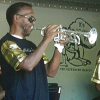Home » Jazz Articles » Album Review » Philadelphia Heritage Art Ensemble: Under The Bridge
Philadelphia Heritage Art Ensemble: Under The Bridge
Fred Adams decided to concentrate all of these references into a single group, the Philadelphia Heritage Art Ensemble. The vitality and youthful enthusiasm that drove hard bop as a confluence of the intricacies of bebop and the soul of gospel are evident again in Adams' group.
From the very start of Under The Bridge, it's evident that the music contains a dynamism that's unlike much of jazz as it's played today, except perhaps in tribute bands like the Art Blakey group that recorded just once on Arkadia.
Rather than referring to hard bop as a nod of the head to the genre's many influences, the members of the Philadelphia Heritage Art Ensemble breathe hard bop. They breathe it in as a creative force that shapes their music, and they breathe it out in insistent dissonances and clipped phrases that inevitably lead into inspired solos.
The first tune, Fred Adams' "Surge," is a perfect example of their style as pianist Sid Simmons sets up an ahead-of-the-beat vamp before the horns assert their concise-to-say-the-least lines. Those lines frame the tune's structure of melodic percussiveness, a concept that pervades the entire album. Sure enough, tenor saxophonist James Stewart develops the potential of the tune in a brief solo enriched with a deep tone and a comfortable style hinting at licks from other saxophone masters. After Stewart, trumpeter Fred Adams, trombonist Clifford Adams, pianist Sid Simmons, bassist Ed Crockett and drummer Craig McIver trade solos over the "I've Got Rhythm" changes, the band is introduced in traditional fashion. McIver's repetition of "Surge's" melodic lines in his full-chorus solo proves up front that he's a drummer who listens to the group's nuances and develops his work rationally and maturely.
Once the listener is aware of the band members' musical personalities, the Philadelphia Heritage Art Ensemble is ready to go forth with its repertoire, consistent in sensibility and free in improvisational opportunity.
More than once, one is reminded of Lee Morgan and Hank Mobley in the styles of Adams and Stewart. While it could be expected that their work would be derivative, that's not so. Instead, they have soaked up the sounds of these revered masters and have allowed them to become a part of their personalities.
As if the musical allusions to Morgan and Mobley weren't enough, the group ends Under The Bridge with three underperformed Hank Mobley tunes, the best-known being "No Room For Squares." The title of the tune itself bears significance to the group, which considers music to be a calling that outsiders, squares, can't understand. With a jump rhythm like Duke Jordan's "Jennine," "No Room For Squares," once again, rips through animated bop phrases over chord changes begging for improvisational workouts. And that's what happens.
The remaining compositions by Fred Adams fall squarely within the hard bop ethic of Mobley's music so that the album attains a wholeness of conception reminiscent of recordings by legends like Curtis Fuller, Clifford Brown or Benny Golson.
At the same time, the music isn't slavishly imitative. It respects the tradition while extending it, as does most jazz. For example, Stewart changes the tone of his saxophone on "Eudora's Waltz" from the deep voicing of Mobley to a long-toned, vibrato-influenced sound more akin to an Ellington approach. "Under The Bridge" puts the trumpet in the lead for the presentation of a minor-mooded tune that ends the bridge's phrases with half-toned deliberateness after the unison lines of the melody split. The concluding sentiment is one of ease and fun when the group brings back Mobley's Latin-tinged "Bossa For Baby."
Not only is the Philadelphia Heritage Art Ensemble successful in reminding us of the ever-presence of exceptional music during the years of hard bop's popularity, but also it consists of a group of excellent contemporary musicians who make the CD a true discovery.
Track Listing
Surge, Under The Bridge, Inner Moods, Cool Breeze, Eudora's Waltz, No Room For Squares, The Morning After, Bossa For Baby.
Personnel
Philadelphia Heritage Art Ensemble
band / ensemble / orchestraFred Adams
trumpetJames Stewart
saxophone, tenorClifford Adams
tromboneSid Simmons
pianoCraig McIver
drumsEd Crockett
bassJames "Hicks" Glenn
bassAlbum information
Title: Under The Bridge | Year Released: 2001 | Record Label: Dreambox Media
< Previous
Cynthia Sayer
Comments
About Philadelphia Heritage Art Ensemble
Instrument: Band / ensemble / orchestra
Related Articles | Concerts | Albums | Photos | Similar ToTags
Philadelphia Heritage Art Ensemble
CD/LP/Track Review
AAJ Staff
Dreambox Media
United States
Under The Bridge
For the Love of Jazz
 All About Jazz has been a pillar of jazz since 1995, championing it as an art form and, more importantly, supporting the musicians who create it. Our enduring commitment has made "AAJ" one of the most culturally important websites of its kind, read by hundreds of thousands of fans, musicians and industry figures every month.
All About Jazz has been a pillar of jazz since 1995, championing it as an art form and, more importantly, supporting the musicians who create it. Our enduring commitment has made "AAJ" one of the most culturally important websites of its kind, read by hundreds of thousands of fans, musicians and industry figures every month.























